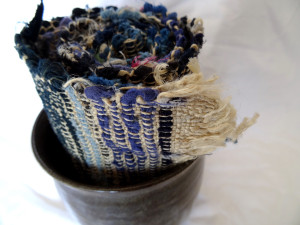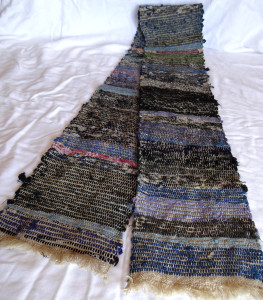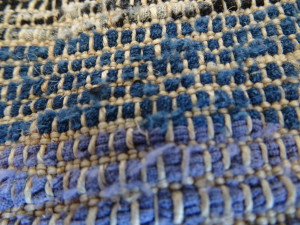What is sakiori?
Saku, Japanese, to tear or rip
Oru, Japanese, to weave
Sakiori, a method of rag-weaving used in Japan by peasant or rural populations from approximately the mid-18th c. through the mid-20th c. for the construction of work garments, obis and other utilitarian textiles
Up until the 20th century (more or less), Japanese peasants lived and worked under extremely difficult conditions. Most worked the land, farming, logging, or fishing, and in good years were able to keep from freezing or starving. The climate was unforgiving, particularly in the northern part of the islands where winters were harsh. There were no native fleece-bearing species whose wool could be spun and made into cloth, and silk was completely out of reach except for the very wealthy. Until the late 15th century, the Japanese clothed themselves almost exclusively in fabric made from bast fibers. Today, we think of fibers such as linen, hemp or ramie when we hear the word ‘bast’. However, of these, only hemp was suitable (or available) to be grown in most of Japan. Much of that, being the finest bast cloth available and worth too much for peasants to keep and wear, was sold to the wealthy classes to provide an income. The poorer people (particularly in the north) wore garments woven from bast fibers taken from plants such as linden, paper mulberry, nettle or wisteria. This clothing, of course, did little to shelter the wearer from the cold.

Sakiori weaving, hemp warp with cotton rag, from Japan, early to mid-20th c. This piece is half of an unfinished work vest called a sodenashi.
It was with considerable interest, therefore, that the people of Japan greeted the arrival of cotton cloth. Although it had been present in Japan since the 15th century via trade from China and then through cultivation in Japan in the warmer regions, it was not until the 19th century that it achieved widespread availability to the rural population. When it did, it was not in pristine bolts ready to cut and sew. In the life-cycle of cotton garments, the poor and the rural communities were last in the chain. Rag merchants bought worn-out clothing from the wealthy, urban populations and transported it to the farming and fishing villages throughout Japan, where the pieces would be sold. The people who bought the rags would then use them to make new cloth in one of several ways. Larger bits of cloth could be layered and stitched together with sashiko (from sasu, to stitch; a form of running-stitch), like an American patchwork quilt, to make clothing or other items. Smaller bits could be used as patches when work garments developed holes. Some garments became studies in patchwork as layer upon layer of patches was applied, worn through, and re-applied. These textiles are now referred to as ‘boro’.
 Poorer-quality, small or narrow rags were torn or cut into strips and used as weft material for the bast-fiber warp threads on the looms of the women in these rural communities (weaving was always the job of women, who had to make all the cloth used by their families) . Different communities and regions of Japan developed slight differences in style and technique, but generally the rags were cut very fine (such as 3 mm), were of indigo-dyed handwoven cotton cloth, and were woven 33-36 cm wide on a type of backstrap loom called a jibata. Sometimes the cloth was woven at ‘half-width’ to be made into a work vest or for children’s clothing. The sakiori cloth was heavy and stiff, suitable to protect the wearer from logging work, fishing, and cold weather.
Poorer-quality, small or narrow rags were torn or cut into strips and used as weft material for the bast-fiber warp threads on the looms of the women in these rural communities (weaving was always the job of women, who had to make all the cloth used by their families) . Different communities and regions of Japan developed slight differences in style and technique, but generally the rags were cut very fine (such as 3 mm), were of indigo-dyed handwoven cotton cloth, and were woven 33-36 cm wide on a type of backstrap loom called a jibata. Sometimes the cloth was woven at ‘half-width’ to be made into a work vest or for children’s clothing. The sakiori cloth was heavy and stiff, suitable to protect the wearer from logging work, fishing, and cold weather.
In some parts of Japan, sakiori continued being made and worn through the mid-20th century (through the end of the post-war period). After that, manufactured cotton fabric became available and affordable for almost all Japanese, and sakiori came to be seen as an indicator of poverty or a lack of modernity. It is only recently that there has been an increased interest in the history of everyday people and in preserving the crafts that they used to survive. This interest coincides with a widespread interest in being ‘green’ and recycling and reusing goods, and boro textiles and sakiori are becoming better-known.
There is very little information available to research sakiori, particularly in English. My main source was this book, which is an exhibition catalog:
Yoshida, Shin-Ichiro and Dai Williams. Riches from rags: saki-ori and other recycling traditions in Japanese rural clothing. San Francisco Craft & Folk Art Museum, 1984.
It is sometimes available for purchase at Sri Threads or Amazon.
Other sources include:
Ignell, Tina. “Riches from Rags” in Väv Magasinet (English Edition), 4/08 p. 10-12.
http://chiyokokumon.com/english/saku.html
http://www.kimonoboy.com/short_history.html
Coming next…Part 2: Why is sakiori relevant to us today?
